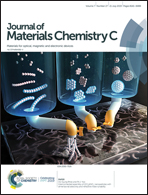Facile p–n control, and magnetic and thermoelectric properties of chromium selenides Cr2+xSe3†
Abstract
Cr2Se3 crystallizes in a NiAs-type structure and is antiferromagnetic with a Néel temperature of TN = 43 K (M. Yuzuri, 1973). Here seven samples with nominal composition Cr2+xSe3 (x = −0.04, −0.02, 0, 0.04, 0.06, 0.08 and 0.12) were prepared by solid state reaction and spark plasma sintering (SPS). The phase composition was characterised by X-ray diffraction (XRD). The electrical conductivity, Seebeck coefficient, thermal conductivity, and Hall effect measurements of all compounds were performed. Both Seebeck coefficients and Hall coefficients show that Cr2+xSe3 are p-type materials when x = −0.04, −0.02, 0 and 0.04, and switch to n-type when x = 0.06, 0.08 and 0.12. An effective magnetic moment μeff = 3.85 μB per Cr ion in Cr2Se3 is obtained by the Curie–Weiss law. We also calculate and compare the band gap values of Cr2+xSe3 by various methods, such as the Arrhenius formula, the Goldsmid–Sharp equation and the optical spectrum. Moderate zT values are obtained for p-type Cr2.04Se3 and n-type Cr2.08Se3 at a relatively low temperature above room temperature. These results indicate the availability of p- and n-type legs in binary transition metal chalcogenides and reveal their potential for wide scale thermoelectric applications.



 Please wait while we load your content...
Please wait while we load your content...